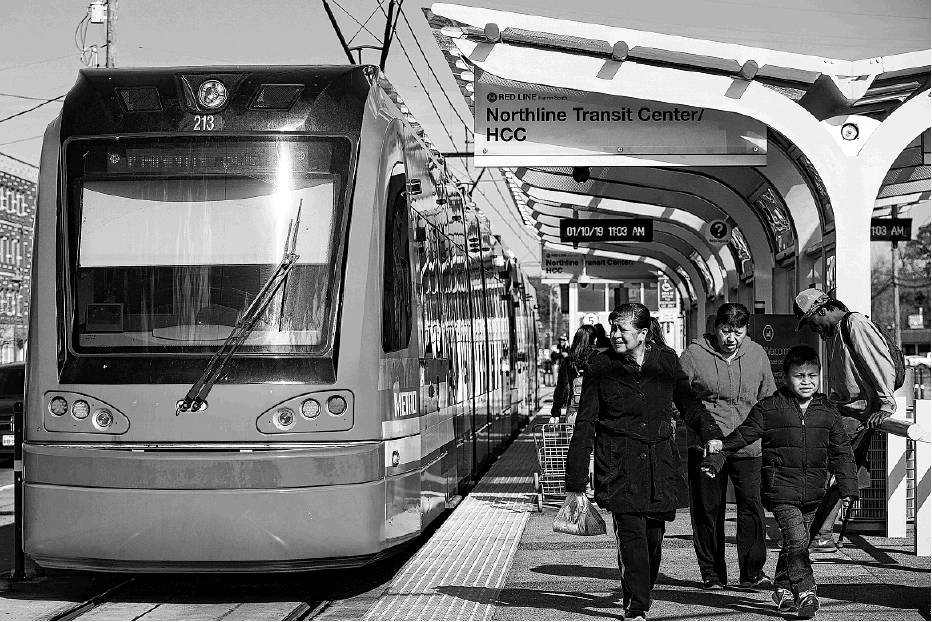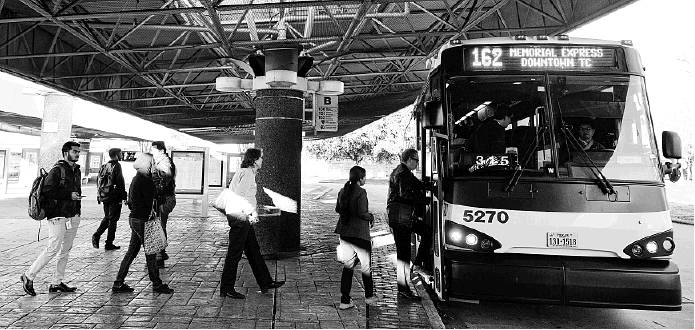TRANSPORTATION
MetroNext 2040 could be an A-plus
Bus improvements can work, but rail extensions are costly
By Tory Gattis
Metro recently released a draft of a $7.5 billion 2040 transit plan they’ve labeled “A Plus” (the previous Plan A plus some additions). Unfortunately it’s more like aBwhen it comes to addressing Houston’s real transportation needs over the next two decades. The plan has some wonderful, cost-effective local and express bus improvements — including bus rapid transit at less than one-third the cost per mile of light rail — but continues to throw mountains of good money after bad on new light rail extensions.
The A+ plan proposes to add 20 miles of new light rail for $2.45 billion, or a third of the overall plan’s cost, to serve only 18,900 trips per day. That means we’re spending $130,000 per daily trip..
The two redundant light rail routes to Hobby airport will serve a trivial 7,200 boardings per day at aprojected cost of a quarter-million dollars per daily boarding , totaling $1.8 billion or around $129 million per mile.
Why is the ridership estimate so low? It might have something to do with the fact that light rail averages 13 miles per hour — so slow that it would take almost an hour to get from Hobby Airport to Downtown. The smarter plan would instead rely upon the far cheaper and faster express lane bus rapid transit service like Bush Intercontinental Airport is getting.
Unfortunately, we're already all too familiar with low ridership on light rail. The $1.4 billion Green and Purple lines have dismally low patronage.
The Green Line had only 5,077 weekday boardings and the Purple Line had only 7,416 weekday boardings. For comparison, the Red Line along Main Street has 53,412 weekday boardings, and the Katy Freeway near Beltway 8 served 366,000 vehicles carrying a half-million people per day in 2017.
Beyond the wasteful inefficiency, rail is also at significant risk of technological obsolescence as autonomous vehicles and shared-ride services like Uber, Lyft and Google’s Waymo continue to evolve. The impact of new technology on public transit is unknown, but it could be hugely disruptive, potentially reducing demand for traditional public transit. That’s why we need a plan which is adaptable to whatever the future may bring.
For future planning purposes and MetroNext, it really does not matter if autonomous vehicles become available in 5 years or decades in the future. Anything built in the MetroNext plan can be expected to be in service to the year 2100 and beyond. MetroNext needs to be ready for autonomous transit, if and when it comes. The plan also needs to maximize mobility benefits of transit investments if autonomous transit is slow to develop or has a minimal impact. That means concrete guideways with rubber-tired vehicles than can evolve as the technology does.
Bus rapid transit guideways substantially reduces risk of obsolescence, since concrete can accommodate the potential autonomous transit vehicles of the future. But we also need to be cautious with bus rapid transit: Yes, it is much less expensive than light rail — but $42 million per mile is still not cheap, and it’s no bargain if it causes traffic chaos at intersections.
That’s why Metro should start with completing the Uptown BRT, then optimize it, and study its impact and effectiveness before building more of it. That’s especially so with he University line along Richmond that will cross several congested intersections and multiple key thoroughfares in Midtown.
For some of the proposed bus rapid transit routes, improved traditional bus service may be the better option since it’s good enough, less disruptive and far less expensive, especially on Gessner where the planned $793 million bus rapid transit line replaces an existing bus route which has only 6,879 boardings per day.
So how should Metro redeploy that $2.45 billion light rail budget instead? They should focus on three priorities:
1) Faster commutes: MetroNext makes substantial regional express improvements to the HOV lane network, including two-way service and service between job centers, but it is still too downtown-centric and fails to provide regional service from all areas to all major job centers. The Texas Medical Center, Greenway Plaza, Galleria area, Westchase and the Energy Corridor all get express service only from limited parts of town, some of which require time-consuming transfers.
The Houston Galveston Area Council predicts jobs will continue to become increasingly dispersed, with less than 17 percent inside the 610 Loop by 2045.
Metro, in partnership with the state and county, needs to serve more of the other 83 percent with interconnected express lanes stitching together the entire region. We don’t need more high-capacity transit, but instead need more routes that can be operated affordably to more destinations with low rider counts at high service levels. The major economic risk is that more employers will give up on being in Houston’s congested core and move to the outer suburbs like ExxonMobil did, draining our tax base and vitality.
2) Equity: LINK Houston recently released areport estimating almost a million Houstonians need better basic bus service. The MetroNext plan calls for 241 miles of BOOST network bus service, which provides more frequent buses, better reliability and sheltered stops for the bargain cost of only $53 million. Why not dramatically expand that to more of the city?
3) Increased ridership and reduced congestion: To buck the national trend of shrinking transit ridership, Metro needs to go big and eliminate fares entirely. Metro’s revenue is mostly sales tax, with just 11.1 percent of operating revenues coming from the fares.
Instead of spending nearly half of the new $2.45 billion transit plan on light rail, Metro could provide free fares for the next 20 years. In fact, it would actually cost less than that because of the internal cost savings from no longer having to collect, process and enforce fares. Free rides makes boarding and trips faster, and it would mean more riders and less congestion – a win whether you ride transit or not. As a bonus, Houston would get a substantial boost to our national reputation as well.
Metro could use the savings to improve the rider experience with more shelters and better sidewalks, making Houston more pedestrian-friendly.
Metro is planning a multi-billion-dollar bond referendum in 2019. Whatever gets passed is likely to shape Houston transportation for better or worse for decades to come. It’s a plan we really need to get right. I encourage every Houstonian to get involved through the MetroNext website and public meetings to help make it a truly A+ plan.
Gattis is a founding senior fellow with the Center for Opportunity Urbanism and writes the Houston Strategies blog.

